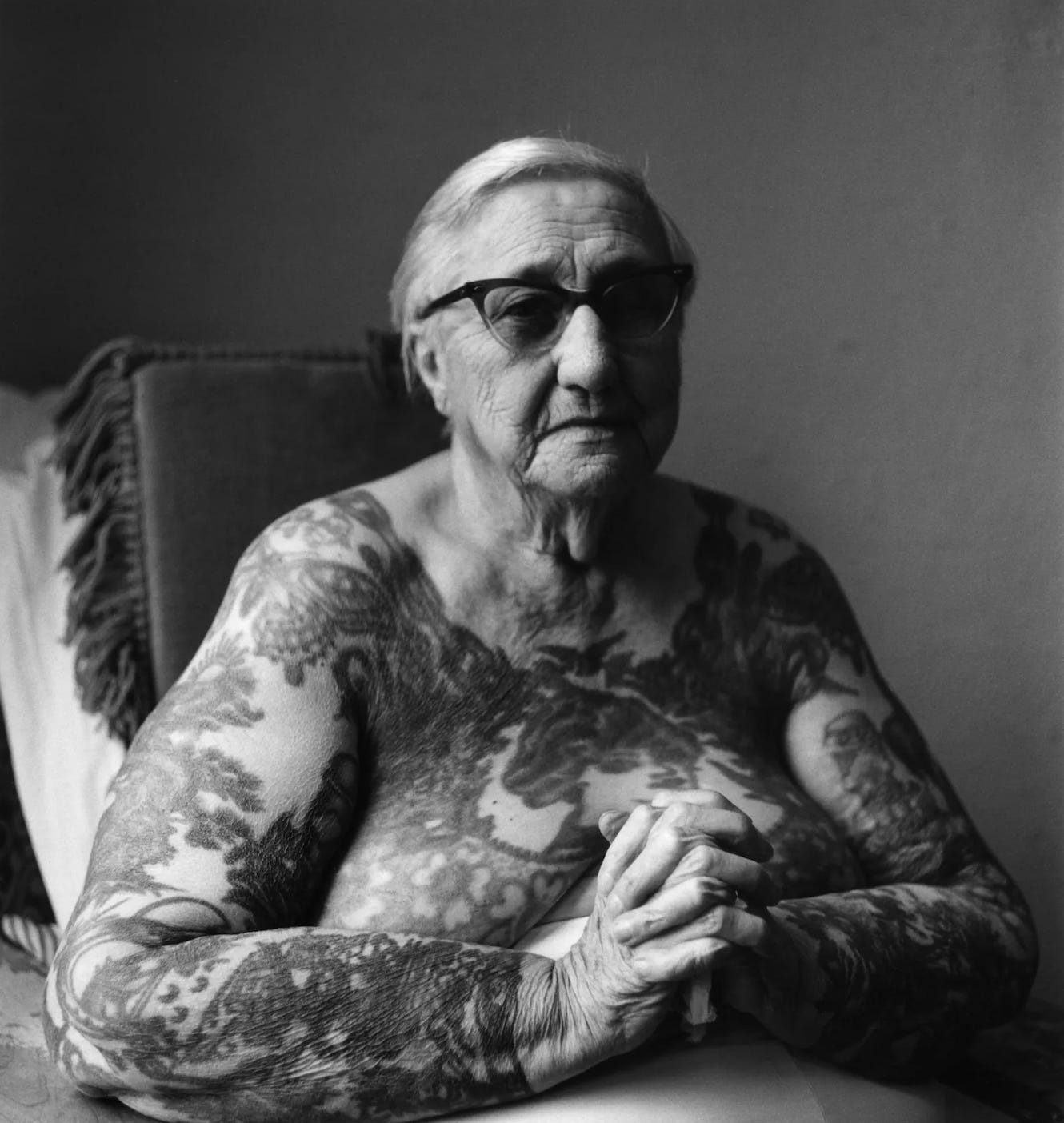January Deep Dive: Early Female Tattooists
One of my favorite aesthetics is that of an old-timey traveling circus. I love to think about the creaky wheels slogging through Midwestern mud, carrying a plywood carriage full of disgruntled lions, peeling rainbow paint on its side advertising THE GREATEST SHOW ON EARTH. I love to imagine the local farm boys, granted one afternoon off, cheeks dusty and eyes wide as a mustachioed emcee takes the stage. I love to picture a sword swallower and a bearded lady and a strong man sharing a late-night cigarette before they pack up and trudge on to the next town. I love it I love it I LOVE IT.
Of course, I am heavily compartmentalizing the horrible parts of this history. The racism and colonialism and child labor and exploitation of disability. P.T. Barnum himself began with only one sideshow character at his side: an enslaved Black woman named Joyce Heth who he billed as the 161-year-old former nurse of George Washington. It wasn’t long after Ms. Joyce that he set up a display of “Aztec Children” who were actually from El Salvador. I won’t even mention what the animals endured.
The story I want to discuss today is (somehow, amongst all that horrible) one of self-autonomy and badassery. One of feminism and partnership. A story of a girl called Maud from Emporia, Kansas.
Maud Stevens ran away to join the circus (because all interesting women do). She performed as an aerialist and a contortionist across America, and at 27 years old she found herself at the 1904 St Louis World’s Fair. There she met “The Tattooed Globetrotter” aka August Wagner aka Gus. He had over 300 tats at the time and claimed to have learned the art from his travels as a merchant seaman around Borneo and Java. After a bit of banter, they agreed to a deal: Maud would go on a date with him if he would teach her to tattoo.


The two embarked on a lucrative lifetime partnership, tattooing each other, themselves, and clientele around the country. Tattoo machines had been invented at this point, but Maud and Gus used the old-school “hokey-pokey” method. Nowadays we would call these tattoos “stick n’ pokes.” Maud and Gus reportedly made around $2000 a week in today’s cash, just for displaying their bodies in these traveling sideshows. If you wanted ink from them, that would be extra. You could even get a tattoo from their 9-year-old daughter Lotteva, who herself embarked on a lifetime of tattooing but was never tattooed herself. Gus described his tattoos as “a history of my life on my breast, a history of America on my back, a romance with the sea on each arm, the history of Japan on one leg, and the history of China on the other.” Maud’s collection was full of colorful lions, birds, butterflies, and trees, as well as her full maiden name on her bicep. Awesome.


Gus died after being struck by lightning in 1941, and Maud lost a battle with cancer in 1961. Lotteva continued their legacy, and her very last tattoo client before she died in 1993 was thee Don Ed Hardy. Further evidence that when Mr. Hardy finds something related to tattooing that is cool, he kills it.
Throughout Maud's career, the tattoo industry was made up of entirely men, and mostly men were getting tattooed. But it wasn’t always a rarity for women to be permanently drawn upon. And - just to underline the distinction here - I’m talking about non-indigenous, predominantly white women. Tattooing has always been an important part of tribal culture, especially in Polynesia and the Americas. If you want to learn about those, I recommend this series as a starting point.
Just know that I’m talking about like, butterflies and hearts that say “Mom” and stuff. Anyway.
In the 19th century, tattooing quietly moved from the prisoner ships en route to Australia to the men of the court themselves. Socialites and aristocrats had tattoos in secret places, usually to proclaim their devotion to a lover, or simply as a commemorative party souvenir. This IYKYK of high society underground tattooing was blown open in 1872 when a man claiming to be Roger Tichborne (the missing heir to the Tichborne baronetcy) was revealed to be an imposter in court, as Roger had very distinctive tattoos, and this fake-Roger did not. Drama!!!

In 1881, teenage princes Albert and George of Wales were tattooed during a trip to Japan. Albert got a dancing crane, and George got a tiger. Even Winston Churchill’s mother, Lady Randolph Spencer-Churchill, had a snake tattoo on her wrist.
Just like body hair, makeup, and cleavage, tattoos have oscillated between acceptance in everyday society and proof of depravity. We go from encouraging it to condemning it every 50-odd years. Even today, when almost everyone I know has a couple of tattoos, I am still occasionally told I will never be hire-able. Told that I have ruined my body. Told that I will look terrible when I am old. Most recently, Rudie was featured by the Instagram Shop… and they photoshopped out my tattoos. Don’t they know that Instagram is where I find new tattoos to get?? Know your audience, Zuck!

In the introduction to her 1997 book “Bodies of Subversion: A Secret History of Women and Tattoo”, author Margot Mifflin writes- “Tattoos appeal to contemporary women both as emblems of empowerment in an era of feminist gains and as badges of self-determination at a time when controversies about abortion rights, date rape, and sexual harassment have made them think hard about who controls their bodies—and why.” But as anyone who has been tattooed a lot can tell you, it's a hobby that can still sometimes feel like the opposite of empowerment - aggro tattooer guys holding your body down, romantic partners suggesting you brand yourself with their name, even just a shop full of dudes ready to roll their eyes at you when you want something (god forbid) girlie.


Maud Stevens Wagner is an incredible example of a woman commanding agency. She refused the path of normalcy and ran towards what excited her. She claimed control of her body and made a fucking fortune off of it. And she wasn’t about to say yes to a date without striking a deal.
So, this year, when you are asked, “B-but what will your tattoos look like when you're old??"
Simply say, "They will look sick as fuck."
Here are a few incredibly talented women tattooers in the Los Angeles area that I have personally been tattooed by and felt safe with. Give them a follow!
See you next time!
xx Ruby












